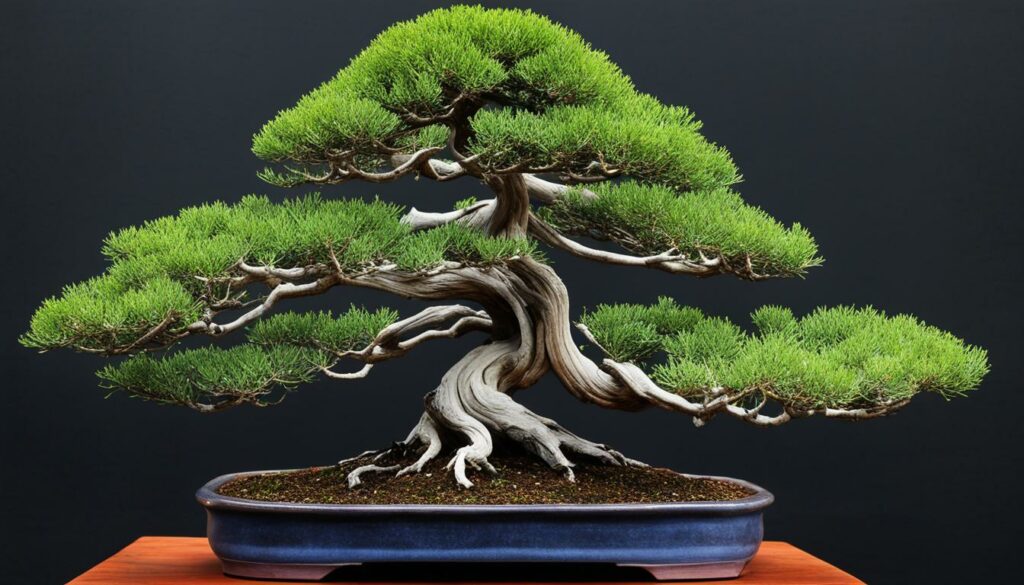Welcome to the world of Juniper bonsai trees! If you’re looking for a stunning outdoor display that is both captivating and resilient, Juniper bonsai trees are an excellent choice. In this comprehensive guide, we’ll explore everything you need to know about Juniper bonsai care and maintenance, including the best techniques for creating an outdoor bonsai display that will impress any viewer.
Key Takeaways:
- Juniper bonsai trees are a beautiful and resilient outdoor display option.
- This guide will provide comprehensive information on Juniper bonsai care and maintenance.
- Learn the best techniques for creating an outdoor Juniper bonsai display that will impress viewers.
- Proper care is essential to ensure the longevity and vitality of your Juniper bonsai tree.
- By following the guidelines outlined in this guide, you can master the art of caring for the majestic Juniper bonsai tree.
Understanding the Juniper Bonsai Tree
Juniper bonsai trees are a popular choice for outdoor bonsai enthusiasts. Their hardy nature and striking foliage make them a great addition to any garden or patio. Before you start caring for your Juniper bonsai, it’s important to understand their unique characteristics and requirements.
- Growth Patterns: Juniper bonsai trees have a slow but steady growth rate, producing new growth in the spring and summer months. They develop a thick, sturdy trunk that supports the tree’s branches and foliage.
- Care Requirements: like any bonsai tree, Juniper bonsai care requires attention to detail. Adequate sunlight, proper watering, and fertilizer are essential components of maintaining a healthy bonsai.
- Outdoor Bonsai: Juniper bonsai trees thrive best in an outdoor environment where they can receive natural sunlight and fresh air. Outdoor placement allows for the proper development and growth of the bonsai tree.
By working to understand the Juniper’s needs and growth patterns, you’ll be able to provide the necessary care for your bonsai. With proper care, your Juniper bonsai will remain a stunning addition to your outdoor environment.
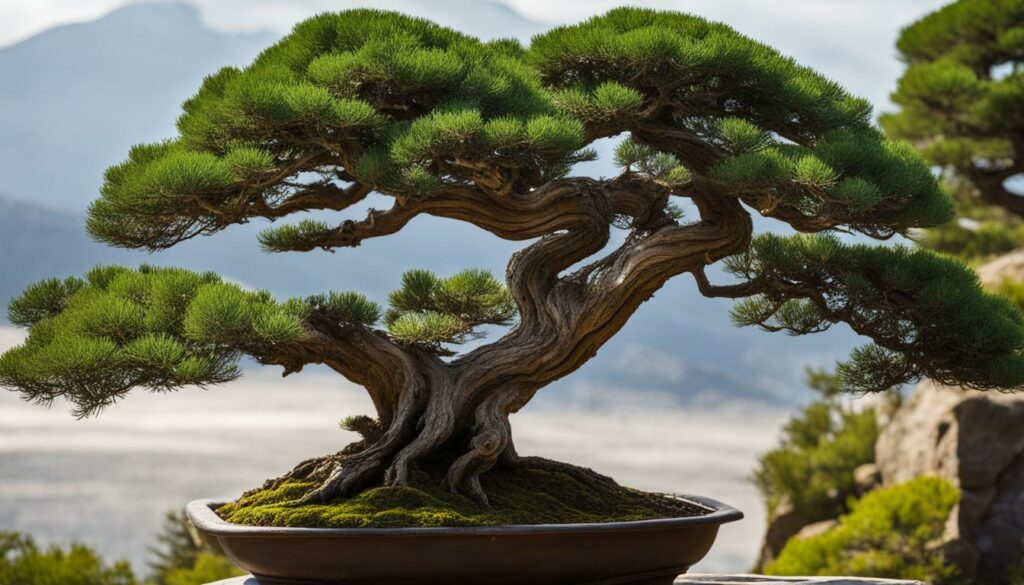
Choosing the Right Juniper Species: Shimpaku
When it comes to selecting the perfect Juniper species for your bonsai, there are plenty of options to choose from. However, one species stands out amongst the rest – Shimpaku. This species is highly prized among bonsai enthusiasts for its compact foliage, graceful silhouette, and natural beauty. But what makes Shimpaku such an ideal choice for your next bonsai creation?
Compact Foliage
One of the most notable traits of Shimpaku Junipers is their finely textured foliage, composed of tiny needles. The dense foliage pads allow for intricate pruning, wiring, and shaping to achieve a flawless bonsai design. Plus, the compact foliage ensures that your Shimpaku bonsai remains visually stunning all year long.
Natural Beauty
Shimpaku Junipers have a unique, rugged appearance, with twisting branches and delicate foliage that grows in clumps. The gnarled, aged bark of this Juniper species adds to its charm and makes it a popular choice for bonsai enthusiasts looking for a visually striking tree.
Graceful Silhouette
By choosing Shimpaku for your bonsai, you’ll be creating a tree with a graceful and elegant silhouette. This species is known for its tall, sweeping branches that create dynamic movement and visual interest in your outdoor bonsai display.
Overall, Shimpaku Junipers are an excellent choice for anyone looking to create a visually striking and unique bonsai tree. With their compact foliage, natural beauty, and graceful silhouette, Shimpaku is a species that is sure to impress. Ensure your Shimpaku Juniper receives proper care, to keep it healthy and thriving as a long-term addition to your bonsai collection.
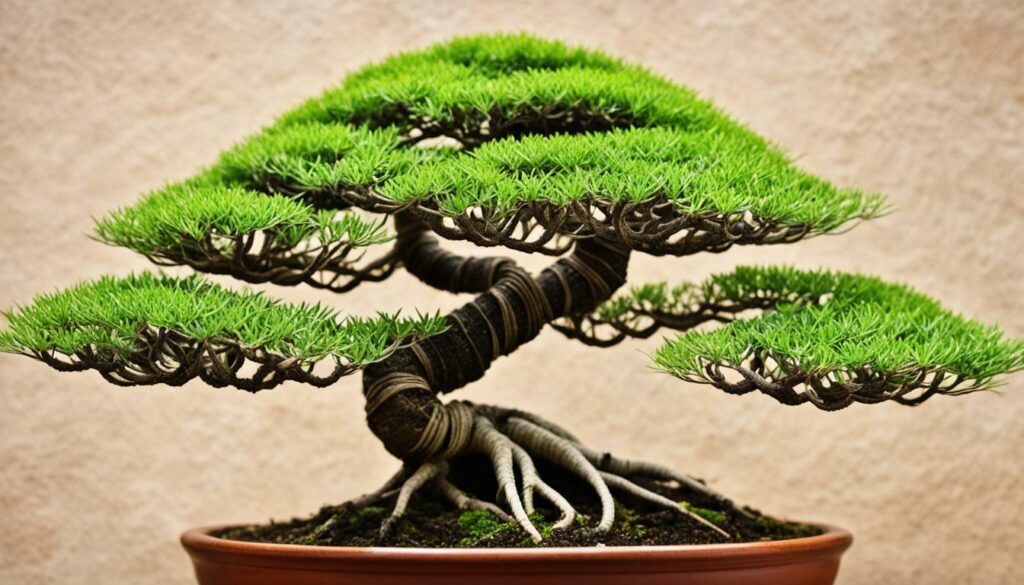
Creating an Outdoor Bonsai Display
When it comes to Juniper bonsai care, the outdoor environment plays a pivotal role in the health and development of your trees. To create a beautiful outdoor bonsai display, you must pay close attention to the following factors:
- Location: Choose a spot that offers ample sunlight, is protected from strong winds, and has good air circulation.
- Sunlight: Juniper bonsai trees require full sun to partial shade. Ensure that your tree receives exposure to sunlight for a minimum of 4-6 hours per day.
- Temperature: While Juniper bonsai trees can withstand cold temperatures, they must be protected from extreme weather conditions such as frost, high winds, and heavy rains.
By following these guidelines, you can create an outdoor bonsai display that showcases the natural beauty and grace of your Juniper bonsai trees. Remember to regularly water and fertilize your bonsai, and protect it from pests and diseases, to keep it healthy and thriving for years to come.
Nurturing Your Juniper Bonsai: Essential Care Tips
As a responsible Juniper bonsai owner, you know that it’s not enough to simply sit back and appreciate the beauty of your tree. Regular maintenance is crucial to ensure its longevity and vitality. To help you on your journey, we have compiled a list of essential care tips for your Juniper bonsai.
Watering
Juniper bonsai trees require regular watering to keep the soil moist but not waterlogged. The frequency of watering will depend on various factors such as the season, climate, and soil type. As a general rule, you should water your Juniper bonsai when the top inch of soil feels slightly dry to the touch. Be sure to use a watering can with a fine nozzle to avoid damaging the delicate needles.
Fertilizing
Fertilization is an important aspect of Juniper bonsai care. Use a balanced, slow-release fertilizer designed for bonsai trees during the growing season (spring to fall). Apply the fertilizer every 3-4 weeks, following the dosage instructions on the package. Avoid fertilizing your Juniper bonsai during the winter months when it is dormant.
Pruning
Pruning helps to keep your Juniper bonsai in shape and promotes healthy growth. Use sharp, clean pruning shears to trim back any unwanted branches or foliage. Focus on maintaining the tree’s natural form and avoid excessive trimming that may damage the tree. Prune your Juniper bonsai in the late spring or early fall, making sure to sterilize your tools between cuts to prevent the spread of disease.
| Tip | Technique |
|---|---|
| Remove dead branches | Cut as close to the main branch/trunk as possible |
| Thin out excess foliage | Remove small branches and twigs that protrude from the main silhouette |
| Reduce branch length | Cut back overgrown branches to preserve the desired shape |
Wiring
Wiring is a technique used to shape your Juniper bonsai tree by gently bending the branches into the desired position. Use soft aluminum or copper wire to wrap around the branch and carefully bend it into shape. Avoid twisting or overlapping the wires, as this may damage the tree. Remove the wire after 6-8 months to prevent it from cutting into the bark as the branch thickens.
Protecting from Extreme Temperatures
Juniper bonsai trees thrive in cool temperatures but can suffer damage from extreme heat or cold. Protect your bonsai by placing it in a cool, shaded area during hot summer afternoons and cold winter nights. Consider using a protective cover or a small greenhouse if you live in an area with extreme weather conditions.
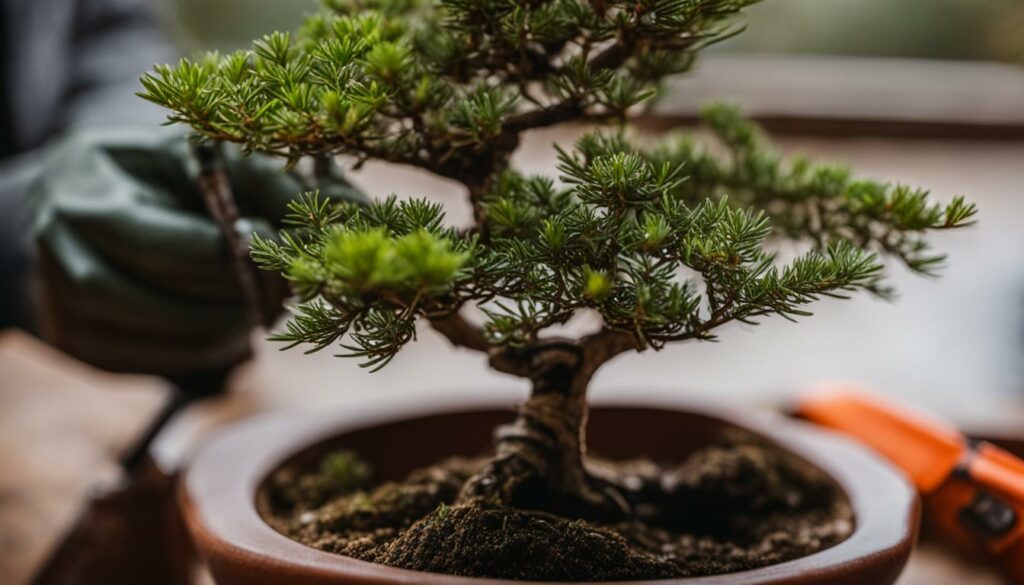
By following these essential care tips, you can enjoy the beauty and vitality of your Juniper bonsai tree for years to come. Remember to provide the ideal conditions of watering, fertilizing, pruning, wiring, and protection from extreme temperatures to ensure the optimal health of your tree.
Needle Care: Preserving the Beauty of Your Juniper Bonsai
To maintain the lush and healthy appearance of your Juniper bonsai, it’s essential to pay close attention to the needles. Here are some needle care tips to keep your Juniper bonsai looking its best:
Watering
Proper watering is key to needle care. Overwatering can cause the needles to turn yellow, while underwatering can cause them to dry out and fall off. Be sure to water your Juniper bonsai thoroughly but allow the soil to dry slightly between watering.
Grooming
Regular grooming will help maintain the shape and fullness of your Juniper bonsai. Use a pair of pruning shears to trim any dead, diseased or damaged needles. It’s also a good idea to remove any needles that are growing in an awkward direction or appear crowded.
Fertilizing
Proper fertilization will promote healthy needle growth and maintain the vibrant green color of your Juniper bonsai. Use a balanced fertilizer during the growing season and a low-nitrogen fertilizer during the dormant season.
Wiring
Wiring can be an effective way to shape your Juniper bonsai but must be done with care. Use wire cutters to remove any wires that are cutting into the needles, which can cause damage. Remove the wire as soon as the desired shape is achieved to prevent any long-term harm to the tree.
By following these needle care tips, you can keep your Juniper bonsai looking beautiful and healthy for years to come.
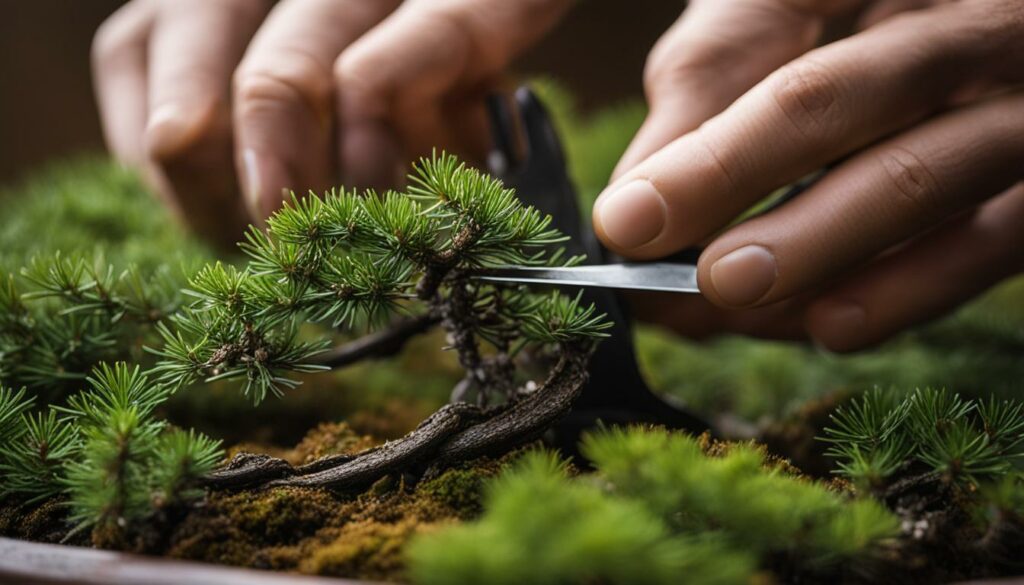
Troubleshooting Common Issues
Even with proper Juniper bonsai care, your tree may encounter problems. It’s essential to know how to identify and address common issues to ensure its continued growth and well-being.
| Problem | Symptoms | Solution |
|---|---|---|
| Pests | Holes in leaves, sticky residue, webs or cocoons on the branches | Apply insecticide or, for a natural solution, try spraying a mixture of water and dish soap |
| Diseases | Discoloration, spots on leaves, deformation, mold or fungus on the branches | Remove the affected parts of the tree and apply a fungicide or bactericide |
| Environmental Stress | Dry or yellow leaves, stunted growth, brittle branches | Adjust the amount of water and sunlight the tree receives, and provide shelter from extreme weather conditions |
If you notice any problems with your Juniper bonsai tree, address them promptly to prevent the issue from getting worse. By taking corrective measures and providing ongoing care, you can help your tree to thrive and reach its full potential.
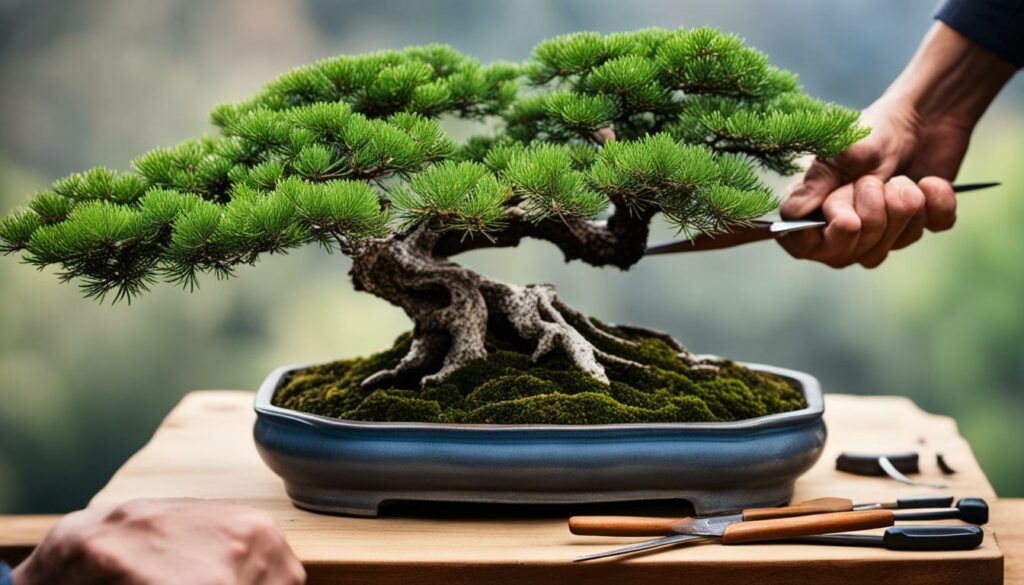
Conclusion
Caring for the majestic Juniper bonsai tree is an art that requires patience, dedication, and knowledge. By following the guidelines outlined in this guide, you can become an expert in nurturing this wonderful species. From understanding the unique characteristics of Juniper bonsai trees to choosing the right location and providing essential care, you can create a stunning outdoor bonsai display that showcases the natural beauty and resilience of this species. So why wait? Start exploring the fascinating world of bonsai tree species Juniper today and discover the joys of creating your own captivating bonsai display!
FAQ
How often should I water my Juniper bonsai tree?
Juniper bonsai trees require regular watering, but it’s important not to overwater them. As a general rule, check the soil moisture before watering. If the top inch of soil is dry, it’s time to water. Be sure to thoroughly saturate the soil until water drains from the bottom of the pot and then allow it to dry slightly before watering again.
Can I keep my Juniper bonsai tree indoors?
While Juniper bonsai trees can be temporarily kept indoors, they are outdoor plants by nature. They require adequate sunlight and proper air circulation to thrive. If you choose to bring your Juniper bonsai indoors, make sure to place it near a south-facing window and monitor the temperature and humidity levels in the room.
How often should I fertilize my Juniper bonsai?
Juniper bonsai trees benefit from regular fertilization during the growing season, typically from spring to fall. Use a balanced, slow-release bonsai fertilizer or a liquid fertilizer diluted to half the recommended strength. Apply the fertilizer every two to four weeks, following the package instructions, to provide the necessary nutrients for healthy growth.
Do I need to prune my Juniper bonsai tree?
Pruning is an essential part of Juniper bonsai care. It helps maintain the desired shape, control growth, and enhance ramification. Regularly prune the new growth to encourage denser foliage and remove any dead or unwanted branches. Pinching and wiring techniques can also be used to refine the tree’s structure and create a more natural appearance.
How do I protect my Juniper bonsai from pests?
Juniper bonsai trees are susceptible to various pests, including spider mites, aphids, and scale insects. Inspect your bonsai regularly for any signs of infestation, such as webbing, sticky residue, or distorted foliage. Treat infestations with appropriate insecticides, following the instructions carefully. Avoid using chemical pesticides if possible and opt for organic alternatives when available.
Can I repot my Juniper bonsai tree?
Repotting is a crucial aspect of Juniper bonsai care and should be done every two to three years to maintain the tree’s health and promote optimal growth. Repot your Juniper bonsai during springtime, using a well-draining bonsai soil mix. Prune the roots by about one-third and replace the soil to provide fresh nutrients and prevent root binding.
